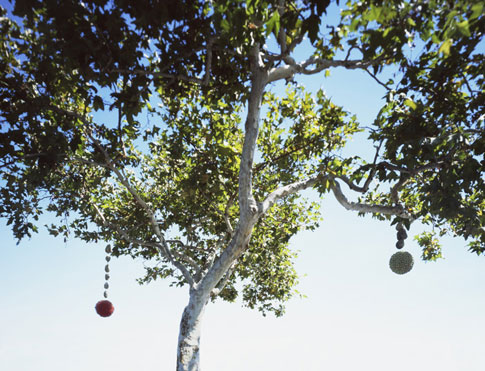Loneliness & River
page 1
January 19, 2006
_small.jpg)
Today I picked up another condom that was sitting by the tree pit of my tree. It's really interesting because it seems like there is a lot of sexual activity that surrounds the tree. People like to park by the tree and people like to have sex near the tree. I don't really know why that is, but it's going on. On the one hand, that's really nice. That means that people are attracted to the tree. They see its beauty. They're getting it on with each other near the tree. That's great.
On the other hand, though, it really makes me feel this profound sense of loss for the tree. The tree is the most isolated thing I can possibly think of. So isolated. It's lonely in the most profound way. It's adorning itself all the time. Maybe one of its purposes in life is to reproduce. A biologist would say that is the primary function of any organism. But, this tree has no chance of reproduction. It's not close enough to other trees and it's separated from the river and from the other trees by asphalt and concrete. But yet, it adorns itself with all these fruit balls. There are fruit balls hanging off it all the time now. It's crazy. It's adorning itself with jewelry like how Xerxes adorned the tree that he loved. But, the tree has no chance to reproduce.
page 2
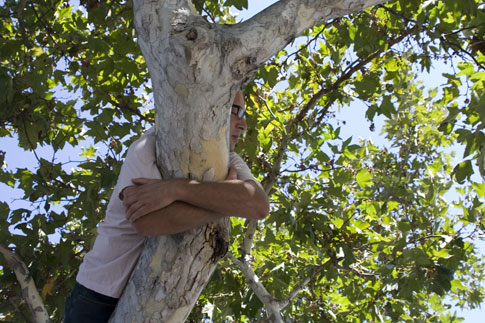
It's the American ideal, I suppose. The solitary individual. John Wayne, the frontier, and all of that. But that ideal, or at least the way this tree is expressing that ideal is completely removed from nature, from its surroundings, and from other members of its species. It's in a boxed car. It's in its own little apartment. It's got no chance. There is no room for connection there.
It wasn't always this way. I learned a lot talking to Tim Brick last week about the history of the river and of the region in general. He was telling me that 15 years ago, there wasn't even asphalt in the lot. People were parking their cars in front of the Rose Bowl, but there was no asphalt. It became fashionable to put in asphalt because it is easier for the cars. But, it did not have to be that way. People were parking there before without the asphalt there. The way the lot was designed had no consideration for the tree at all. It was just about an easy way for the cars to get in and an easy way for them to get out.
page 3
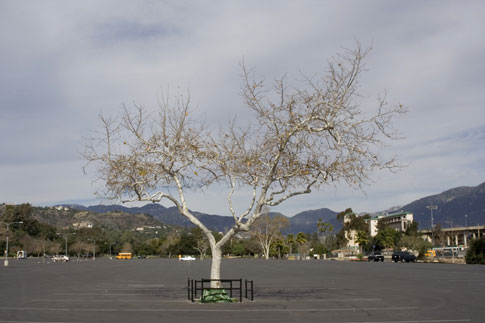
I learned a lot from Ellen Mackey too and Scott Wilson, when I talked to them last week. They looked at the lot and they said "Oh my God, look at this lot." The lot was designed for those purposes, but it does not have the tree in mind. The water does not drain into the trees. A well designed lot would have a vegetative swale, where the rain water would drain into the tree pits. But, it's not that way. If you look at the slope of the lot, the water is not going there. It's going into the river – which is already polluted – as it pollutes it more.
And, the river is just conceived of as a drain. There is a drain going into the larger drain of the Arroyo Seco River that is literally about 20 feet away from the base of the tree. All that water is being funneled into that drain when it could be going into my tree. It's so close. All that water is so close, and the tree is not getting enough water. I'm bringing water to the tree, but I'm sure that I'm not bringing it enough.
page 4
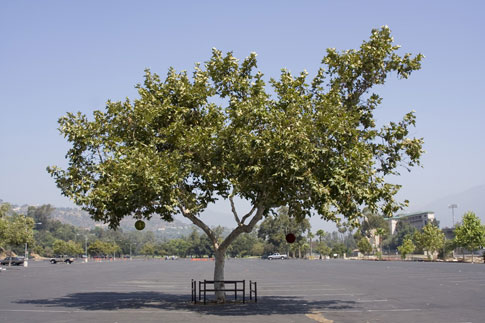
Look at the city of Los Angeles. We are importing millions of gallons of water, and we are getting rid of all of this water, and then we have things like sewage eruptions in Santa Monica and Manhattan Beach. The system is not working properly. And, besides that, it's wasteful.
Anyway, it didn't use to be this way. There were sycamore trees, willows, and oaks that were hanging out by the Arroyo Seco River. It's a powerful, huge, beautiful river. Fish used to be in there. And, then, we modernized the stream. And, we turned it into a drain. In 1920 we put in a dam. There were good reasons for it. I understand it. It wasn't like, let's kill the trees and put in a dam. No. They weren't thinking about it that way, but that is basically what happened. There was a big flood. There was a big flood in 1914. 45 people died. Homes slid down the hills. There were more floods in 1934 and 1938. So, they put in the dam, and there were no longer all these beautiful fish in the river. Just from putting in the dam.
page 6
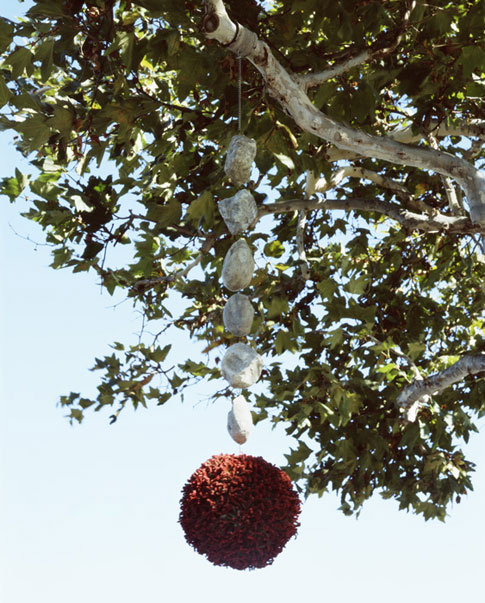
It's a huge river. It's 22 miles long. It's beautiful. And there were all these people that used to use it. Native Americans were getting fish from the river. Cattle were grazing near the river in the Mission Period. After that, people were using the river for irrigation for their orange orchards. And, then they put in the Rose Bowl. 1922. But even then, there were cars there. But, at least it wasn't paved.
But now, there are no fish there. The river is incredibly polluted. JPL – yah, they didn't intend it – but look what they did. The river is so polluted, it's dangerous to even play in the river. Of course, you can't drink it at all. There is all this bacteria in there. It's a mess. You can't even play there. Still, that's our water. And, the tree can handle it, I suppose. Hopefully. It's better than nothing.
The larger issue is that the tree is disconnected from its environment. The largest tree in the lot is doing much better than my tree. But, there is no tree pit at all. It's just doing better because it is right next to the river. But, they paved right up to the base of the tree. At least there's a little tree pit around this tree. But, why isn't the tree pit bigger? Why isn't the tree connected to the river? I don't get it and it makes me sad.
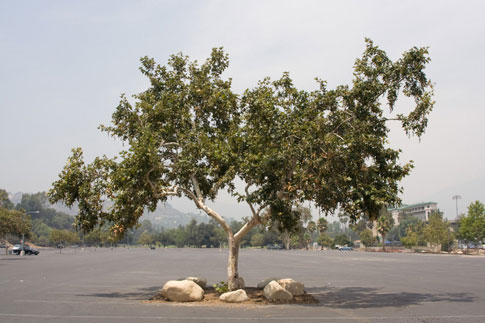
page 7
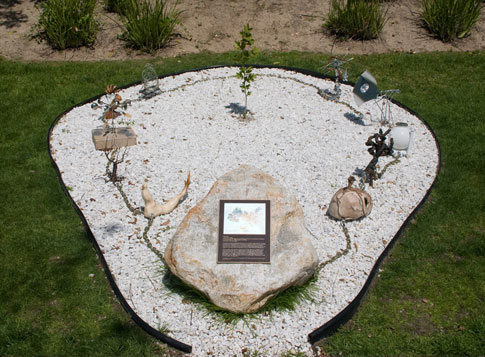
On the other hand, though, it's not like it's me and the tree against the world. Tim Brick, this guy's amazing. He helped orchestrate the restoration of the southern Arroyo Seco region. Yes. They turned the region into a Disneyfied version of what it was before, but at least they did something. They did a lot. These activists that I was talking to – Scott Wilson and Ellen Mackey – were telling me that there is momentum and interest from a number of people to actually get rid of all of the asphalt around the Rose Bowl. There is potential actually, if I talk to enough people or use this film in a way, there is the possibility – albeit remote because we are going against football corporate interest – of getting rid of all of those lots and replacing them with something like decomposed granite, which is what the hills are made of that surround the area. Reconnect it to what it was before. That would allow water to come in. It would allow oxygen to feed the tree… The tree is not getting enough oxygen. The asphalt is acting as a barrier against the oxygen. And, that's a huge problem. So, anyway, I have allies. And, I have to say I love them. All the people that are interested in this tree, I love em. So, it's not just me and the tree against the world. There are other people out there. But, still, it's disconnected. It's completely disconnected right now.
RELATED PLACES Los Angeles




